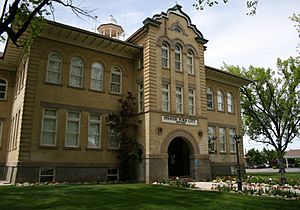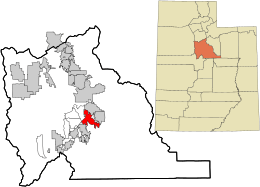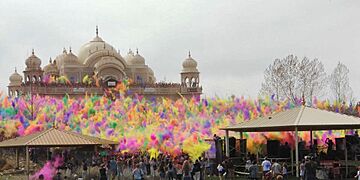Spanish Fork, Utah facts for kids
Quick facts for kids
Spanish Fork, Utah
|
|
|---|---|

Spanish Fork city offices
|
|
| Motto(s):
"Pride and Progress"
|
|

Location in Utah County and the state of Utah
|
|
| Country | United States |
| State | Utah |
| County | Utah |
| Settled | 1851 |
| Incorporated | January 17, 1855 |
| Named for | Spanish Fork (river) |
| Area | |
| • Total | 16.21 sq mi (41.98 km2) |
| • Land | 16.21 sq mi (41.98 km2) |
| • Water | 0.00 sq mi (0.00 km2) |
| Elevation | 4,666 ft (1,422 m) |
| Population
(2020)
|
|
| • Total | 42,602 |
| • Density | 2,628.1/sq mi (1,014.82/km2) |
| Time zone | UTC−7 (Mountain (MST)) |
| • Summer (DST) | UTC−6 (MDT) |
| ZIP code |
84660
|
| Area code(s) | 385, 801 |
| FIPS code | 49-71290 |
| GNIS feature ID | 2411948 |
| Website | www.spanishfork.org |
Spanish Fork is a city located in Utah County, Utah, in the United States. It is part of the larger Provo–Orem area. In 2020, about 42,602 people lived there. This makes Spanish Fork one of the bigger cities in Utah.
The city sits in the Utah Valley, with the Wasatch Range mountains to the east and Utah Lake to the northwest. A major highway, I-15, runs along the northwest side of the city. Spanish Fork is close to other towns like Payson, Springville, and Salem.
Contents
History of Spanish Fork
Spanish Fork was first settled in 1851 by members of The Church of Jesus Christ of Latter-day Saints. These settlers were part of the Mormon Pioneers' movement to settle the Utah Territory. The city's name comes from a visit by two Spanish friars, Silvestre Vélez de Escalante and Francisco Atanasio Domínguez, in 1776. They followed the Spanish Fork river through the canyon. They were looking for a new path from Santa Fe, New Mexico, to the Spanish missions in California. They described the area as having "spreading meadows" and plenty of wood and water, perfect for settlements and raising animals.
Early Settlers and Forts
In 1851, some settlers, led by William Pace, started farms in the Spanish Fork area. They called their spot the Upper Settlement. A larger group gathered at what became known as the Lower Settlement, near the Spanish Fork river. In December 1851, Stephen Markham became the leader of the first church group there.
In 1852, Latter-day Saints also started a settlement called Palmyra to the west. They planned a town with a temple square. A fort and a school were built in Palmyra in 1852. When the Walker War began in 1853, many farmers in the area moved into the Palmyra fort for safety. Some people preferred a different spot and built "Fort St. Luke" at the mouth of Spanish Fork Canyon. Another fort, known as the "Old Fort," was built about two miles south of the city center in 1854.
Icelandic Pioneers and Treaties
Between 1855 and 1860, pioneers from Iceland arrived in Spanish Fork. This made Spanish Fork the first place in the United States where Icelanders settled permanently. The city also gave its name to the 1865 Treaty of Spanish Fork. In this treaty, the Utes were told by President Abraham Lincoln to move to the Uintah Basin.
What's the Weather Like?
Spanish Fork has a climate with cold, snowy winters and hot, dry summers. This type of climate is called a dry-summer continental climate.
| Climate data for Spanish Fork Power House, Utah, 1991–2020 normals, extremes 1909–present | |||||||||||||
|---|---|---|---|---|---|---|---|---|---|---|---|---|---|
| Month | Jan | Feb | Mar | Apr | May | Jun | Jul | Aug | Sep | Oct | Nov | Dec | Year |
| Record high °F (°C) | 69 (21) |
72 (22) |
81 (27) |
87 (31) |
99 (37) |
109 (43) |
108 (42) |
104 (40) |
101 (38) |
89 (32) |
79 (26) |
68 (20) |
109 (43) |
| Mean maximum °F (°C) | 51.1 (10.6) |
59.6 (15.3) |
71.9 (22.2) |
80.2 (26.8) |
88.9 (31.6) |
97.0 (36.1) |
100.1 (37.8) |
97.8 (36.6) |
91.9 (33.3) |
81.7 (27.6) |
66.7 (19.3) |
53.7 (12.1) |
101.1 (38.4) |
| Mean daily maximum °F (°C) | 38.3 (3.5) |
45.1 (7.3) |
56.6 (13.7) |
64.2 (17.9) |
74.3 (23.5) |
85.7 (29.8) |
93.1 (33.9) |
90.7 (32.6) |
81.1 (27.3) |
66.8 (19.3) |
50.8 (10.4) |
38.4 (3.6) |
65.4 (18.6) |
| Daily mean °F (°C) | 30.1 (−1.1) |
35.4 (1.9) |
44.7 (7.1) |
51.1 (10.6) |
60.0 (15.6) |
69.5 (20.8) |
77.1 (25.1) |
75.2 (24.0) |
66.0 (18.9) |
53.7 (12.1) |
40.9 (4.9) |
30.6 (−0.8) |
52.9 (11.6) |
| Mean daily minimum °F (°C) | 22.0 (−5.6) |
25.7 (−3.5) |
32.7 (0.4) |
37.9 (3.3) |
45.6 (7.6) |
53.3 (11.8) |
61.1 (16.2) |
59.7 (15.4) |
50.9 (10.5) |
40.5 (4.7) |
31.0 (−0.6) |
22.7 (−5.2) |
40.3 (4.6) |
| Mean minimum °F (°C) | 5.3 (−14.8) |
9.7 (−12.4) |
18.3 (−7.6) |
25.7 (−3.5) |
33.4 (0.8) |
41.1 (5.1) |
51.6 (10.9) |
50.8 (10.4) |
37.9 (3.3) |
26.7 (−2.9) |
13.9 (−10.1) |
5.2 (−14.9) |
0.8 (−17.3) |
| Record low °F (°C) | −16 (−27) |
−20 (−29) |
1 (−17) |
10 (−12) |
21 (−6) |
29 (−2) |
38 (3) |
38 (3) |
26 (−3) |
8 (−13) |
−6 (−21) |
−19 (−28) |
−20 (−29) |
| Average precipitation inches (mm) | 2.11 (54) |
2.08 (53) |
2.16 (55) |
2.47 (63) |
2.11 (54) |
0.97 (25) |
0.57 (14) |
0.74 (19) |
1.40 (36) |
1.81 (46) |
1.80 (46) |
1.97 (50) |
20.19 (513) |
| Average snowfall inches (cm) | 17.3 (44) |
14.1 (36) |
6.8 (17) |
4.2 (11) |
0.0 (0.0) |
0.0 (0.0) |
0.0 (0.0) |
0.0 (0.0) |
0.0 (0.0) |
0.5 (1.3) |
7.4 (19) |
15.7 (40) |
66.0 (168) |
| Average precipitation days (≥ 0.01 in) | 9.9 | 9.5 | 9.3 | 10.8 | 8.8 | 4.9 | 3.8 | 5.4 | 6.1 | 7.1 | 8.1 | 9.8 | 93.5 |
| Average snowy days (≥ 0.1 in) | 6.5 | 5.2 | 2.9 | 1.9 | 0.0 | 0.0 | 0.0 | 0.0 | 0.0 | 0.3 | 3.3 | 6.7 | 26.8 |
| Source: NOAA | |||||||||||||
Who Lives in Spanish Fork?
| Historical population | |||
|---|---|---|---|
| Census | Pop. | %± | |
| 1860 | 773 | — | |
| 1870 | 1,450 | 87.6% | |
| 1880 | 2,304 | 58.9% | |
| 1890 | 2,686 | 16.6% | |
| 1900 | 3,327 | 23.9% | |
| 1910 | 3,751 | 12.7% | |
| 1920 | 4,035 | 7.6% | |
| 1930 | 3,727 | −7.6% | |
| 1940 | 4,167 | 11.8% | |
| 1950 | 5,230 | 25.5% | |
| 1960 | 6,472 | 23.7% | |
| 1970 | 7,284 | 12.5% | |
| 1980 | 9,825 | 34.9% | |
| 1990 | 11,272 | 14.7% | |
| 2000 | 20,246 | 79.6% | |
| 2010 | 34,691 | 71.3% | |
| 2020 | 42,602 | 22.8% | |
| U.S. Decennial Census | |||
In 2010, there were 34,691 people living in Spanish Fork. The city had 9,069 households and 7,885 families. The population was quite young, with about 40.9% of people being under 18 years old. Most residents (90.9%) were European American. About 10.6% of the population identified as Hispanic or Latino.
Community and Culture
Spanish Fork has a strong community spirit. Many residents are members of The Church of Jesus Christ of Latter-day Saints. The city has many churches, including a Presbyterian Church and a Lutheran church built by Icelandic immigrants. There is also a Baptist church and a Roman Catholic church.
A special place in Spanish Fork is the Sri Sri Radha Krishna Temple. It was built by a follower of the International Society for Krishna Consciousness. This temple is known for its colorful festivals.
Many different cultures have helped shape Spanish Fork. You'll find people with roots from Iceland, Switzerland, Spain, England, Ireland, and Scotland.
Fun Things to Do and See
The Angelus Theatre in Spanish Fork is a great place to see live shows. They have plays, live music, and rock bands.
Exciting Events in Spanish Fork
Spanish Fork hosts five big events every year. These are Fiesta Days, Icelandic Days, the Harvest Moon Hurrah, the Festival of Lights, and the Festival of Colors.
Icelandic Days Celebration
The Icelandic Association of Utah holds Iceland Days every year in June. This celebrates Icelandic Independence Day, which is on June 17. Spanish Fork was the first permanent Icelandic settlement in the U.S. Icelanders who joined The Church of Jesus Christ of Latter-day Saints were asked to leave Iceland. They came to Spanish Fork and have kept their culture alive through this yearly event.
Harvest Moon Hurrah Festival
The Harvest Moon Hurrah is a fun event sponsored by the Spanish Fork Arts Council. It happens on a Saturday in September, close to the full moon. Kids can do crafts and activities. There's a giant mural to paint, storytellers, and old-fashioned family photos. You can also enjoy hay rides with live bluegrass music and other entertainment.
Festival of Colors
The Sri Sri Radha Krishna Temple in Spanish Fork celebrates Holi. This event is called the Festival of Colors. Thousands of people come from all over the country to throw colored powders and celebrate.
Fiesta Days Celebration
Every July, Spanish Fork hosts "Fiesta Days." This event celebrates Pioneer Day. It includes a rodeo, a craft fair, a parade, a duck race, and a fireworks show on July 24th.
Schools in Spanish Fork
Spanish Fork built its first schoolhouse in 1862. It was a one-room building that served the city for almost 50 years. In 1910, the Thurber School was built. Today, it's used as a city office building. Spanish Fork is part of the Nebo School District.
Here are some of the public schools in Spanish Fork:
- Spanish Fork High School
- Maple Mountain High School
- Landmark High School (an alternative school)
- Spanish Fork Junior High School
- Diamond Fork Middle School
- Brockbank Elementary
- Canyon Elementary
- Larsen Elementary
- Park Elementary
- Rees Elementary
- Riverview Elementary School
- East Meadows Elementary
- Sierra Bonita Elementary
- Maple Ridge Elementary
There are also private schools like the New Haven School for girls, and a charter school called the American Leadership Academy.
City Infrastructure
Clean Energy Projects
In September 2008, the Spanish Fork Wind Project was finished. This project has nine wind turbines that can produce a lot of electricity. At full power, they can make enough energy for up to 6,000 homes. This is a big step for Spanish Fork in using clean wind energy.
Famous People from Spanish Fork
- Isaac Asiata, a football player
- Scott Brumfield, a football player
- Kaycee Feild, a bareback bronc rider
- Jaren Hall, a football player
- Gail Halvorsen, a U.S. Air Force pilot known as the "candy bomber"
- Ab Jenkins, a politician and racing driver
- Lucky Blue Smith, a male model
See also
 In Spanish: Spanish Fork para niños
In Spanish: Spanish Fork para niños


